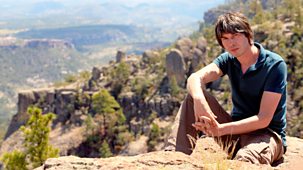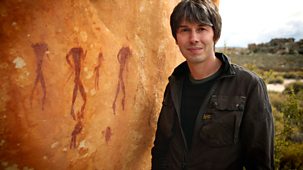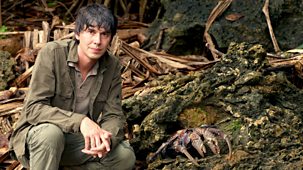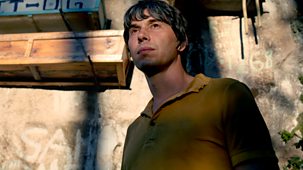
Original Series: 4. Size Matters
In this episode, Brian travels around Australia to explore the physics of the size of life. Beginning with the largest organisms on our planet, a forest of giant eucalyptus trees, he then takes to the seas to get up-close with an ocean giant - the great white shark. From the safety of a steel cage Brian explains how the distinctive streamlined contours of the great white have been shaped by the physics of water. \n\nBack on land, Brian heads out to the dry dusty outback. Here he tracks the largest living marsupial, the red kangaroo, to see how giants on land adapt to gravity. This all pervasive force influences the way in which living things move and the upper limit on how large they become.\n\nThrough the myriad species of insects in Queensland's rainforests, Brian begins his journey into the world of the small. At smaller scales, the effects of gravity are negligible and it is another force - the electrostatic force - that is dominant. This explains how flies and other insects can appear to defy gravity, using the traction of the electrostatic force to scale vertical windows. \n\nBut as life gets smaller, the very nature of the world appears to change as Brian explains with the aid of the tiny trichogramma wasp. This is one of the smallest multicellular life forms on Earth. For them, the atmosphere is a highly viscose environment - in a similar way to how we experience liquid - and so the trichogramma has to 'swim' through the air.\n\nEven smaller still, are the thrombolites of Lake Clifton, near Perth. These mysterious growths are made up of colonies of bacteria, the smallest free-living life forms on Earth. Here, Brian finds that the size of life has a lower limit that is governed by the size of atoms and fundamental particles, which in turn are subject to the laws of physics.\n\nThe size you are not only dictates which forces of nature affect your life, it also influences your 'speed of life'. The tiny southern bent wing bat of South Australia loses heat so fast that they struggle to find enough food to stay alive. But as life gets larger, the pace of life - or metabolism - slows and this has profound consequences on life expectancy. \n\nBrian explores this idea upon the tropical Christmas Island. This is a land of crabs of all different shapes and sizes. The largest - and most distinctive - are the giant robber crabs whose legs can span a metre. Not only are they the largest land invertebrate, they outlive their smaller cousins, some reaching well over 80 years of age. So the physics of size shapes life in many ways, not least the amount of years you get to enjoy it.
Source: BBC 4
Most recent episodes of Wonders of Life
Wonders Of Life
Original Series: 5. Home
As far as we know, there is only one place in the universe on which life has taken hold - earth - but for how much longer will this distinction remain? Astronomers are on the br ...
17-12-2024
BBC 4
Wonders Of Life
Original Series: 4. Size Matters
In this episode, Brian travels around Australia to explore the physics of the size of life. Beginning with the largest organisms on our planet, a forest of giant eucalyptus tree ...
10-12-2024
BBC 4
Wonders Of Life
Original Series: 3. Endless Forms Most Beautiful
The universe is almost entirely devoid of life. Earth, the planet we call home, seems to defy the laws of physics. It is teeming with life in all colours, shapes and sizes. No-o ...
03-12-2024
BBC 4
Wonders Of Life
Original Series: 2. Expanding Universe
Amidst the rich natural history of the United States, Professor Brian Cox encounters the astonishing creatures that reveal how the senses evolved. \n\nEvery animal on Earth expe ...
26-11-2024
BBC 4
Wonders Of Life
Original Series: 1. What Is Life?
In this episode Brian Cox visits South East Asia's 'Ring of Fire'. In the world's most volcanic region he explores the thin line that separates the living from the dead and pose ...
19-11-2024
BBC 4
Most popular episodes of Wonders of Life
Wonders Of Life
Original Series: 2. Expanding Universe
Amidst the rich natural history of the United States, Professor Brian Cox encounters the astonishing creatures that reveal how the senses evolved. \n\nEvery animal on Earth expe ...
26-11-2024
BBC 4
Wonders Of Life
Original Series: 1. What Is Life?
In this episode Brian Cox visits South East Asia's 'Ring of Fire'. In the world's most volcanic region he explores the thin line that separates the living from the dead and pose ...
19-11-2024
BBC 4
Wonders Of Life
Original Series: 4. Size Matters
In this episode, Brian travels around Australia to explore the physics of the size of life. Beginning with the largest organisms on our planet, a forest of giant eucalyptus tree ...
10-12-2024
BBC 4
Wonders Of Life
Original Series: 3. Endless Forms Most Beautiful
The universe is almost entirely devoid of life. Earth, the planet we call home, seems to defy the laws of physics. It is teeming with life in all colours, shapes and sizes. No-o ...
03-12-2024
BBC 4
Wonders Of Life
Original Series: 5. Home
As far as we know, there is only one place in the universe on which life has taken hold - earth - but for how much longer will this distinction remain? Astronomers are on the br ...
17-12-2024
BBC 4





